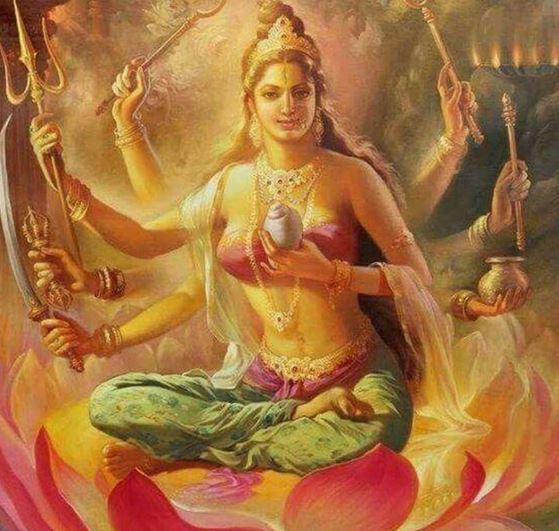Shakti

Shakti is a Sanskrit term that refers to the divine feminine energy or power, and it is one of the most important concepts in Hinduism, particularly in the Shakta tradition and Tantra. The word "Shakti" literally means "power", "energy", or "strength" and is often personified as a goddess who embodies the dynamic and creative force of the universe. In Hindu cosmology, Shakti is considered the active force that drives creation, preservation, and destruction in the universe.
Key Aspects of Shakti:
1. The Feminine Principle:
Shakti is regarded as the feminine counterpart to Shiva, the divine masculine energy in Hinduism. While Shiva represents consciousness, stillness, and transcendence, Shakti represents action, energy, and manifestation. Together, these two forces are often seen as complementary and inseparable, representing the union of spirit (Shiva) and matter (Shakti). In many interpretations, Shakti is considered the creative energy that brings life to the universe, while Shiva is the principle of pure being or formlessness.
2. Shakti as a Goddess:
In many forms of Hinduism, Shakti is personified as a goddess. This goddess takes on various forms, each embodying different aspects of divine power and cosmic energy. Some of the major goddesses associated with Shakti include:
-
Durga: The goddess of strength, protection, and destruction of evil. She is often depicted riding a lion and holding weapons in her multiple arms.
-
Kali: The fierce and transformative goddess associated with destruction and dissolution, but also with liberation and spiritual awakening.
-
Parvati: The consort of Shiva and the mother goddess, symbolizing love, fertility, and devotion.
-
Lakshmi: The goddess of wealth, prosperity, and beauty, symbolizing abundance and good fortune.
-
Saraswati: The goddess of knowledge, wisdom, and arts, representing intellectual and creative energy.
3. Cosmic Energy:
Shakti is the cosmic energy that exists throughout the universe. It is seen as the force that animates all creation, making everything from the smallest particle to the largest celestial body pulsate with life. In this view, Shakti is not just a concept but an actual, living, and active force that is responsible for the movement and transformation of all things in the universe. This energy is often described as dynamic, ever-changing, and full of potential.
4. Shakti and Creation:
Shakti is intimately connected with the process of creation in Hindu cosmology. She is believed to be the creative power that brings the universe into existence, sustains it, and ultimately dissolves it. This cyclical process is represented in many stories, including the myth of Durga's battle with the buffalo demon Mahishasura, where Shakti's power is invoked to restore cosmic order by destroying evil forces.
5. Shakti in Tantra:
In Tantric traditions, Shakti is central to the spiritual path. Tantra teaches that Shakti is the ultimate source of all spiritual energy and that the goal of the practitioner is to awaken Kundalini, the dormant spiritual energy within the individual. Kundalini is often depicted as a coiled serpent at the base of the spine, and its awakening is said to lead to the rise of Shakti through the chakras, culminating in spiritual enlightenment and union with the divine.
-
In Tantric practices, Shakti is often invoked through mantras, rituals, meditation, and yoga to awaken the dormant energies within the practitioner.
-
The ultimate goal of Tantra is the union of Shakti (the goddess, energy) and Shiva (the god, consciousness), symbolizing the merging of matter and spirit, creation and transcendence.
6. Shakti and the Kundalini Energy:
One of the most prominent representations of Shakti is in the form of Kundalini, a latent energy within each individual, often likened to a coiled serpent. The awakening of Kundalini energy through spiritual practices is believed to lead to higher states of consciousness and enlightenment. This awakening allows Shakti to rise through the chakras, the energy centers in the body, leading to spiritual realization and self-liberation.
7. Shakti and the Divine Feminine:
Shakti is also a representation of the Divine Feminine, which is central to the worldview of many traditions in Hinduism. As the feminine principle, Shakti transcends traditional gender distinctions and is understood as the power that lies behind all creation, transformation, and destruction. It signifies the importance of feminine energy in the spiritual and material worlds, calling for respect and reverence for both feminine and masculine energies in achieving balance and harmony.
Shakti in Contemporary Understanding:
-
In modern spiritual movements, particularly in the New Age and feminist spirituality, Shakti is often invoked as a symbol of empowerment, creativity, and inner strength. The concept of Shakti encourages individuals to awaken their own divine energy and connect with their inner power to create change in their lives and the world around them.
-
Shakti is increasingly celebrated as a symbol of female empowerment and the nurturing, life-giving forces of nature, as well as a reminder of the importance of balancing the masculine and feminine energies within each person.
In Summary:
Shakti is the embodiment of divine energy in Hinduism, often personified as a goddess. It represents the active, creative, and dynamic force that drives creation, sustenance, and destruction in the universe. Shakti is central to Tantric practices and is closely associated with the awakening of spiritual energy (such as Kundalini), and the union of the divine feminine with the divine masculine. It signifies not only physical power but also spiritual power and enlightenment. Shakti is celebrated as the source of all life and is revered in various forms, such as Durga, Kali, and Parvati, in the broader Hindu religious tradition.

